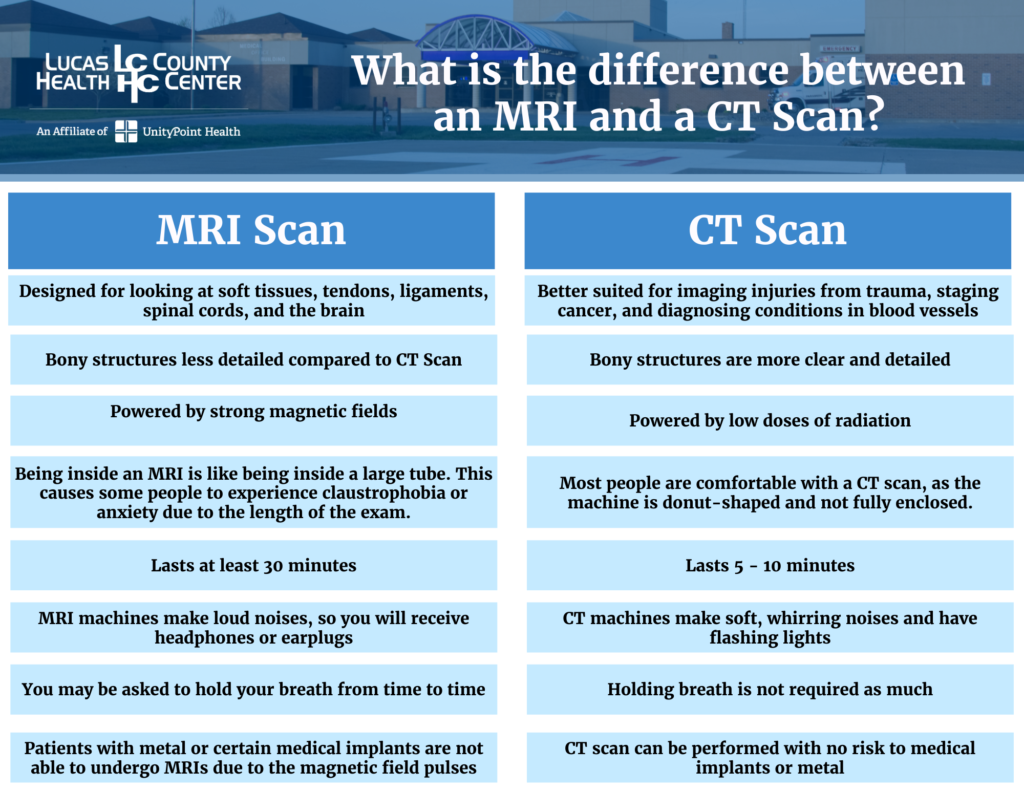Your provider says you need a scan and immediately visions of large machines and strange sounds fill your head. You may even be a bit worried about the diagnosis and what it means for your health. But do you really know what you’re in for when your provider sends you to get a CT or MRI? It is easy to get the two scans confused, but there is a big difference, especially when you’re lying on the table!
Providers order CT scans and MRI scans to help diagnose a variety of medical conditions. While both scans have similar uses, they produce images in very different ways.
In this article we will explain the difference between the scans as well as their uses, procedures, and safety. That way you’ll know what to expect before you even show up for your appointment.
What are they?
CT scans and MRI scans are two different ways of creating detailed images of internal body parts. Providers use these images to detect abnormalities, such as fractures in bones, tumors on organs, joint damage, and more.
What is a CT/CAT Scan? What is the procedure like?
A CT is an x-ray machine that’s hooked up to a computer. You will lie flat on the table and a pencil-thin beam will take cross-sectional images of your body. The beam will rotate around your body and take image slices of you like a loaf of bread.
CT does use radiation to capture clear images. We do everything we can to make sure you are getting the lowest dose of radiation possible while still getting the highest quality images. The CT scan is so quick that most patients’ worries about radiation exposure quickly disappear.
CT scans are also relatively quick and patients typically have no problem getting a CT. You may be put in an uncomfortable position for a few minutes, but the scan is done so quickly that it is rarely a problem for a patient to hold the position.
CT is good for:
- Imaging bone, soft tissue, and blood vessels at the same time
- Pinpointing issues with bony structures (injuries)
- Evaluating lung and chest issues
- Detecting cancers
- Imaging patients with metal implants
What is a MRI scan? What is the procedure like?
MRI stands for Magnetic Resonance Imaging. MRI uses a powerful magnetic field, radio frequency pulses, and a computer to produce images of your organs, soft tissues, bone, and other internal structures. During the scan, you will lie on a table that will slide into the machine. Traditionally the space where you will go into the MRI machine is a tube or tunnel. Some patients may experience anxiety or feel claustrophobic due to the shape of the machine and the length of the scan.
Another piece of equipment used during an MRI is the coil, which acts as an antenna for the radio frequency pulses and helps the machine gather images of a particular part of your body. The coil might be a frame that snaps over your head or shoulder, it might be placed on the table before you lie down, or it could be wrapped with Velcro around the body part that is being scanned.
Even if an MRI is the right scan for you – you might not be right for it. If you have ever had any metal in your body, such as a pacemaker, a spinal cord stimulator, a nerve simulator, an ear implant, or a stent, it might not be safe for you to have an MRI. Some newer implants are safe to take into an MRI scanner, but you’ll be asked a lot of questions when you book your appointment to make sure. Orthopedic metal in the bone (like a rod in the hip or shoulder) is always going to be safe.
MRI is good for:
- Imaging organs and soft tissue of internal structures
- Showing tissue difference between normal and abnormal
- Imaging without radiation
The Differences between MRI and CT
From a patient perspective, the major difference between the two is the shape of the machine. CT is describe as a “donut” while the MRI is more like a “tanning bed.” The other major difference is the length of the scan. Typically, an MRI will take at least 30 minutes, while a typical CT scan only takes about 5 minutes.
Your Care
Our team of radiologists and technologists are experts in imaging. They can help you and your provider in selecting the right technology for your exam. Our goal is to provide the best imaging service and the right procedure, at the right time, with accurate results for each patient. Remember, if you have a question about your scan, never be afraid to ask. We want you to feel relaxed and comfortable before, during, and after your appointment.

